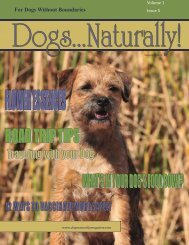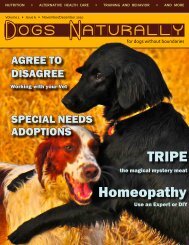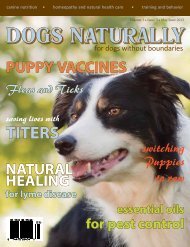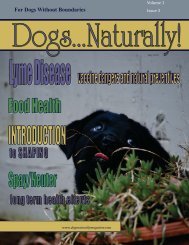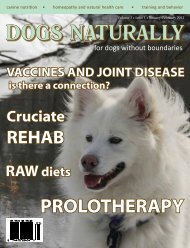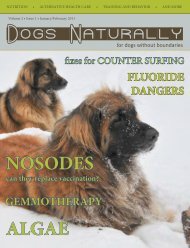For Dogs Without Boundaries - Dogs Naturally Magazine
For Dogs Without Boundaries - Dogs Naturally Magazine
For Dogs Without Boundaries - Dogs Naturally Magazine
Create successful ePaper yourself
Turn your PDF publications into a flip-book with our unique Google optimized e-Paper software.
When a vaccine is administered, the organism is injected<br />
directly into body tissues, bypassing the local<br />
immune responses. When this happens, much of the<br />
immune system is rendered useless. The body then<br />
must compensate by increasing the activity of the balance<br />
of the system, and the defenses begin in a compromised<br />
state, with the organism already in the blood<br />
stream. Within the blood stream, the primary aspects<br />
of the immune system are antibodies, proteins which<br />
attach to the organism and assist in its destruction.<br />
Although normally only a part of the defenses, these<br />
antibodies become heavily responsible in a vaccine<br />
(injected) induced invasion, thereby initiating a hyperactive<br />
(increased) response. Additionally, the preparation<br />
of vaccines often breaks down the integral structure<br />
of the virus or bacteria, exposing internal strictures<br />
such as viral DNA or RNA (depending on the virus)<br />
to the immune system, leading to heavy antibody<br />
production against these nucleoproteins. Since nucleoproteins<br />
are relatively similar in all life forms, the<br />
host antibodies may lose the induced hyperactivity of<br />
antibody production. The result may be antibody mediated<br />
destruction of host tissue, and autoimmune disease.<br />
In a natural exposure, antibodies would be directed<br />
more at external structures, which are less similar<br />
to host tissues thus less likely to induce cross reactions.<br />
Incidentally, autoimmune diseases are occurring<br />
more frequently than ever; could this be a reason<br />
• He supports the use of combination vaccines and I<br />
strongly do not.<br />
• He thus recommends in cats to combine panleukopenia<br />
(FPL), Calicivrus (FC), and Rhinotracheitis (FVR)<br />
in one schedule; I have recommended to use FVR-FC<br />
intranasal vaccine only if needed, and separately from<br />
FPL.<br />
• In dogs he would combine Distemper (CD), Parvo<br />
(CPV), and Hepatitis, and possibly Corona and<br />
Parainfluenza. I would recommend CD and CPV<br />
only, and not combined.<br />
Aside from the above considerations, vaccines commonly<br />
contain materials other than the organism to<br />
which immunity is desired. These materials may be<br />
added as preservatives, adjuvants (materials to<br />
stimulate immune response, usually added to noninfectious<br />
[killed] vaccines), or antibiotics. Preservatives<br />
and adjuvants include such toxins and carcinogens<br />
as aluminum (alum), mercury (thimersol), and<br />
formaldehyde. Also, many foreign proteins are included<br />
if the organism was grown on foreign tissue<br />
such as chicken or duck embryos. Even more frightening,<br />
nonintended organisms are sometimes accidentally<br />
incorporated as contaminant "stowaways". In<br />
1995 The Washington Post reported that MMR vaccine<br />
produced by Merck & Co. along with some influenza<br />
and yellow fever vaccines, contained an enzyme<br />
known as reverse transcriptase. This enzyme is associated<br />
with retroviruses such as FeLV, FIV, and HIV, and<br />
has the capability to alter genetic information, leading<br />
to serious diseases such as leukemia and other cancers.<br />
These diseases may take years to manifest, so correlation<br />
with vaccination may be impossible, masking a<br />
potentially causative relationship.<br />
The recommended schedules (age to vaccinate) are<br />
from Dr. Schultz, with a few changes as follows:<br />
www.dogsnaturallymagazine.com January/February 2010 | 19



